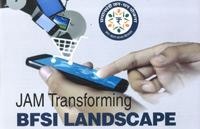Transforming BFSI Landscape : Mandating FI Under JAM
December, 2015
A survey has noted that combining the Jan Dhan Yojana, Aadhaar and Mobile numbers can help reduce the leakage of subsidies for a variety of commodities like rice, wheat, pulses, sugar kerosene, LPG, naptha, water, electricity, diesel, fertilizer, iron ore, railways, which the poor are unable to benefit. It points out that by December 2015 the total number of Aadhaar enrolments in the country is expected to exceed 1 billion (it stood at 720 million in December 2013) and that linking an Aadhaar Number to an active bank account is key to implementing direct income transfers to the poor.
To this, Mr. Thyagarajan Seshadri, Vice President – Banking Relations, EPS said, “If we look at the government’s approach, they are trying to provide social benefit schemes without any intermediary, Its schemes define leakages in the financial system, which can be fixed. Now as a way out, the government is opting for schemes wherein technology can play a large role. EPS has played a role where beneficiaries are identified and included in the mainstream through bank accounts”.
The Jan Dhan Yojana scheme aims to increase the number of bank accounts and is specifically targeted at the poor. India has over 900 million cell phone users and close to 600 million unique users (people with just one SIM), and in such a scenario mobile money can help deliver the direct transfer benefits to the poor. The way to reduce leakages in the PDS system is by increasing the direct transfer scheme, which can be utilised better if Aadhaar, Mobile and Bank accounts are linked more efficiently.


